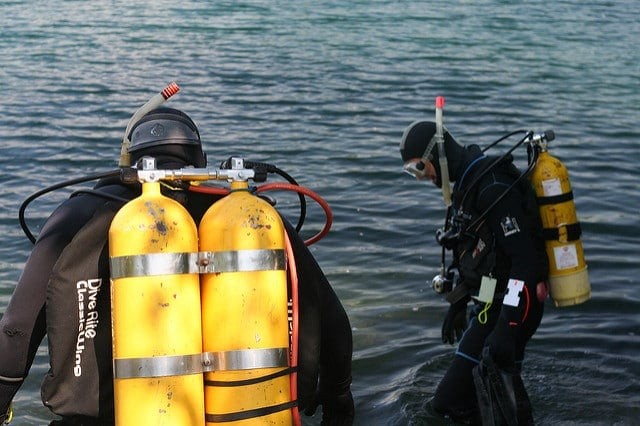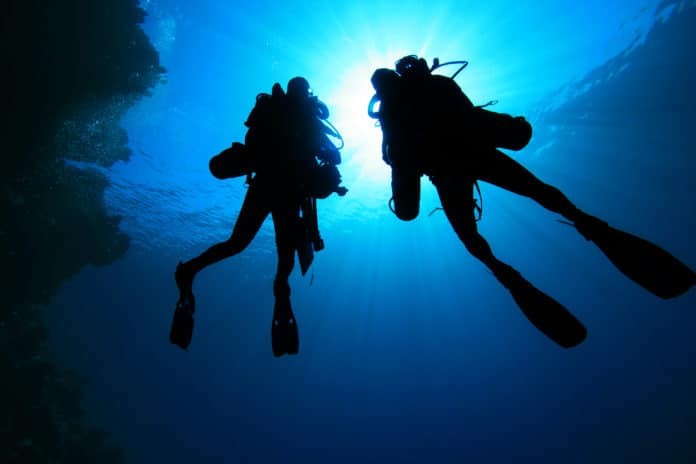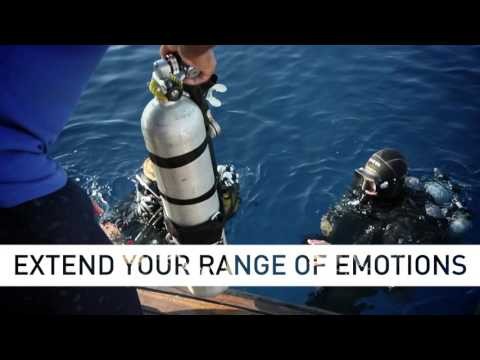Tec diving or Technical diving has always been something viewed in awe by many a beginning divers. We see divers loaded down with tanks and enough gadgets hanging off them to decorate a Christmas tree. We know they are going to be down much longer than we are, maybe deeper, but definitely exploring more. We hear them talk between themselves using terms that seem too difficult for our understanding. But what is Tec diving?
There is no agreed upon definition of technical diving, each organization has their own definition. However, The National Oceanic and Atmospheric Administration (NOAA) does have a definition that is generally accepted.
“Technical diving is a term used to describe all diving methods that exceed the limits imposed on depth and/or immersion time for recreational scuba diving. Technical diving often involves the use of special gas mixtures (rather than compressed air) for breathing”.
The generally accepted definition of recreational diving allows trained and qualified divers to descend to 130 feet/ 40 meters staying within prescribed No Decompression Limits. So by NOAA definition, a Tec dive is any dive either deeper than 130 feet/ 40 meters or that requires a staged decompression stop.
Technical diving is a challenge well beyond what recreational divers are used to. Many of the specialties within technical diving required skills that are tuned to very little tolerances. Cave divers and wreck divers need buoyancy control that is near perfect.
Getting Started in Tec Diving
The limits of recreational diving give us two reasons why we might want to explore becoming a technical diver. We might want to stay down longer, we might want to go deeper or both. In the “The DeeperBlue.com Beginners Guide to Scuba Diving” series I touched on becoming a Tec diver in the article, Tec Diving Expanding Beyond Recreational Scuba. I also overview “Decompression Diving – What Is It and Should I Avoid It?” another aspect of Tec.
The different training agencies have their own route to becoming a technical diver. The most common are the introduction of a single staged decompression stop and the introduction of doubles. SSI with their Extended Range Nitrox diving and PADI with their Tec 40 program are two of the most popular programs for recreational divers who want to ease into technical diving or expand their limits a little. To enter these programs a diver must be a Nitrox diver and a deep diver with a number of qualifying dives in their logbook.
It is important to note that neither of these two courses will allow you to go deeper. They are intended to introduce you to decompression theory and its practical application. Divers who plan to extend their range and stay down longer must have a full understanding of the physical underwater environment and its affect on their bodies.

Increased Risk
The need to do a stage decompression to avoid DCS is not the only concern while entering the technical diving realm. As divers learn in the deep diver and Nitrox diver courses, as dives become longer and deeper, there is a concern about the effects of oxygen and the potential for CNS toxicity. Nitrox divers personally check the oxygen content of every cylinder they use and mark on the tank the safe Maximum Operating Depth (MOD). This is one of the steps that divers must do to help ensure they stay within acceptable safe ppO2 (partial pressure of oxygen) and CNS Toxicity levels.
Like NDL times, these are guidelines as each individual will have a difference tolerance and that can vary day to day and be impacted by other factors. A pp02 of 1.4 is the level considered safe and is the level frequently used for planning purposes. The Tec programs also introduce you to using a decompression gas to add conservatism to the decompression dive. The decompression gas is used starting at the staged decompression stop. Divers can use up to an EAN 50 (Enriched Air Nitrox with 50% oxygen) as their decompression gas. The MOD using a pp02 of 1.4 for EAN 50 is only 18 meters/ 60 feet. If a diver uses this gas at depth, it could kill him.
There are also increased risk from hypothermia, CO2 build-up, dehydration, and more. These courses help give you the tools to understand and manage these risks.
What to Expect
The SSI Extended Range Nitrox Diving and PADI Tec 40 program can be done with your own equipment with maybe just a few added items of gear. Since you are a Nitrox diver, you will likely already have a diver computer that meets the need for a multi-gas dive computer. A Delayed Surface Marker Buoy, another mandatory item, has become a must have for most divers. The only other item will be the pony bottle setup that can be used with Nitrox. One benefit of taking one of these courses is getting to use doubles. While you can complete the course using a single cylinder and a pony bottle, consider using the course to introduce you to using doubles. The breathing gas you use can be air or Nitrox suitable for the depth you will be diving. The pony bottle will be used for your decompression gas which can be up to EAN 50. Both programs require that you provided a doctor signed a medical certificate.
The programs each have knowledge sections followed by a practical application. There are four open water dives. Each of the four dives has a set of task and skills associated with them. Using software programs, the divers plan a dive beyond No Decompression Diving Limits (simulated in the early dives) including the need for a stage decompression stop for a period of time less than 15 minutes (10 minutes for PADI). The divers proceed to dive their plans including a number of skills/ tasks within the dive. These skills/ task will be new activities for most divers and some of them are primarily needed for using doubles.
The PADI Tec 40 program simulates decompression diving during the first three dives. Divers perform a stage decompression stop, however, The dive profile is within NDL. The last dive in the Tec 40 is a true staged decompression dive with one stop of less than 10 minutes.
The SSI Extended Range Nitrox program simulates a decompression dive on the first two dives but plans true staged decompression dives with one stop of up to 15 minutes for the last two dives.
Is Tec Diving Right For You
I have been on deep dives where a diver had inadvertently enter an unplanned deco situation. For myself, since I am fully knowledgeable about my dive computer, It would not be a major concern for me. My computer will guide me to the steps I need to use. Still, having the extra knowledge these Tec Diving courses offer and the additional skills seems very useful. As is the practice under supervision of an instructor. The ability to move up to using doubles is certainly appealing. I have a few wrecks that I enjoy but will love the extra time exploring that the doubles will allow. Do you have any favorite dives that would be better as a stage decompression dive?


